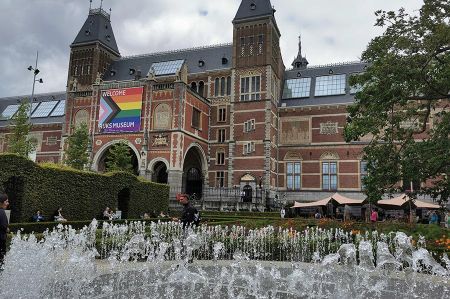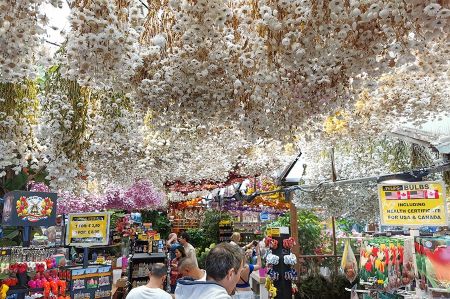From the Rijksmuseum Amsterdam to the flower market
- Written by Portal Editor
For this day we planned a city stroll along the Amsterdam canals and bridges, which we wanted to start at the Rijksmuseum / Reichsmuseum.
Once again we went from the campsite through various parks, only partly along the streets to the centre of Amsterdam. And again, as with the boat tour, we chose the Rijksmuseum as the starting point for our city tour because there were numerous and safe parking spaces for the bikes. Maybe it was luck, but no one came close to our bikes during all our tours.
Rijksmuseum – the Dutch national museum
 The Rijksmuseum Amsterdam can be considered one of the most important museums of arts, crafts and history in Holland, and it is not for nothing that it is called the Dutch National Museum. It stores and displays a large collection of paintings from the Dutch Golden Age and a comprehensive collection of Asian art objects as well as artifacts relating to Dutch history in various permanent exhibitions. With around 8,000 exhibits on display, it was declared a Rijksmonument. In 2015, the Rijksmuseum was even named European Museum of the Year.
The Rijksmuseum Amsterdam can be considered one of the most important museums of arts, crafts and history in Holland, and it is not for nothing that it is called the Dutch National Museum. It stores and displays a large collection of paintings from the Dutch Golden Age and a comprehensive collection of Asian art objects as well as artifacts relating to Dutch history in various permanent exhibitions. With around 8,000 exhibits on display, it was declared a Rijksmonument. In 2015, the Rijksmuseum was even named European Museum of the Year.
 The painting collection includes, among others, works by Jacob van Ruysdael, Frans Hals, Jan Vermeer, Jan Steen, Rembrandt van Rijn and Rembrandt's students. If you want to go in, you should definitely register in advance, as the number of visitors is extremely high.
The painting collection includes, among others, works by Jacob van Ruysdael, Frans Hals, Jan Vermeer, Jan Steen, Rembrandt van Rijn and Rembrandt's students. If you want to go in, you should definitely register in advance, as the number of visitors is extremely high.
Rembrandt: The collection includes the following paintings by Rembrandt van Rijn:
The Night Watch
The heads of the cloth makers' guild
The Jewish bride
Apostle Peter denies Christ
Jeremiah laments the destruction of Jerusalem
Saskia with veil
Titus as a monk
Self-portrait as the Apostle Paul
Tobias and Anna with the goat
 Jan Vermeer: The following paintings about Jan Vermeer can be found in the Rijksmuseum Amsterdam:
Jan Vermeer: The following paintings about Jan Vermeer can be found in the Rijksmuseum Amsterdam:
Maid with milk jug
The love letter
Letter reader in blue
The little street
If the waiting time is too long for you, you shouldn't be afraid to walk around the building, because the architecture and gardens around it is well worth the effort.
Building architecture – a combination of Gothic and Renaissance elements
 An architectural competition for a new museum building was announced as early as 1863, but the designs fell short of expectations. The later architect Pierre Cuypers also took part in this competition and only achieved second place with his work. The design was a combination of Gothic and Renaissance elements. The final selection and the start of construction took until October 1, 1876. The building received rich decorations, both inside and out, inspired by Dutch art history. They were selected in an additional competition, which was won by B. van Hove and J. F. Vermeylen for the sculptures, Georg Sturm for the painting and W. F. Dixon for the glass design.
An architectural competition for a new museum building was announced as early as 1863, but the designs fell short of expectations. The later architect Pierre Cuypers also took part in this competition and only achieved second place with his work. The design was a combination of Gothic and Renaissance elements. The final selection and the start of construction took until October 1, 1876. The building received rich decorations, both inside and out, inspired by Dutch art history. They were selected in an additional competition, which was won by B. van Hove and J. F. Vermeylen for the sculptures, Georg Sturm for the painting and W. F. Dixon for the glass design.
The new building was finally opened on July 13, 1885.
The front of the museum faces the Stadhouderskade. The back faces the Museumplein in a prominent location, where the Van Gogh Museum, the Stedelijk Museum Amsterdam and the Concertgebouw are also located. More on that later.
Cyclists delay reopening
 As early as 1890, the new building was supplemented by a building that was created from demolished historical buildings. The elements used provide an overview of Dutch architectural history. From 2003 to 2013, the museum was renovated again and partially gutted according to plans by the Andalusian architects Antonio Cruz and Antonio Ortiz. Many of the old interior decors were restored. During these measures, only parts of the painting collection were accessible. The exhibition “The Masterpieces” was located in the already finished rooms of the part of the building now known as the “Philips Wing”.
As early as 1890, the new building was supplemented by a building that was created from demolished historical buildings. The elements used provide an overview of Dutch architectural history. From 2003 to 2013, the museum was renovated again and partially gutted according to plans by the Andalusian architects Antonio Cruz and Antonio Ortiz. Many of the old interior decors were restored. During these measures, only parts of the painting collection were accessible. The exhibition “The Masterpieces” was located in the already finished rooms of the part of the building now known as the “Philips Wing”.
 The renovation was originally supposed to be completed in 2008.
The renovation was originally supposed to be completed in 2008.
In particular, protests by cyclists whose route to the Oud-Zuid district ran through the Rijksmuseum site led to extensive replanning and construction delays. Instead of the originally planned cycle route around the museum, a passage for pedestrians and cyclists was integrated into the building. Something like this probably only exists in Holland! Today “only” cyclists and tourists get in each other’s way.
Rings of canals and bridges decorated with flowers
 Already on the other side of the Rijksmuseum building is one of the mooring points for canal tours, which we also used. Now we cross the flower-decorated bridge on the way to the flower market.
Already on the other side of the Rijksmuseum building is one of the mooring points for canal tours, which we also used. Now we cross the flower-decorated bridge on the way to the flower market.
Until 1862, the flower market was located at “Sint Lucionwal”. After the Nieuwezijds Voorburgwal canal was drained in 1883, the market got its current location on the Singel, between the Koningsplein and the Muntplein. At that time the market was called “Trees and Plants Market” (Bomenen plantenmarkt). In the 19th century, flower sellers traveled by boat on the Amstel and sold their goods directly from the boat.
 Even today the market stalls are housed on fixed boats. The official name today is “Drijvende bloemenmarkt” (literally: floating flower market) and this market is open daily.
Even today the market stalls are housed on fixed boats. The official name today is “Drijvende bloemenmarkt” (literally: floating flower market) and this market is open daily.
The market is approximately 230 m from Rembrandtplein and 800 m from Leidseplein. In recent decades, the Bloemenmarkt has become primarily an attraction for tourists.
The range is adjusted accordingly. In addition to ornamental and cut flowers, many types of flower bulbs and souvenirs are available, which we also wanted to take advantage of. However, we were unlucky in our selection because the onions didn't open.
 However, the numerous but small cheese shops and butcher shops are also interesting both because of the tasting and because of their presentation. It's a shame that the number of tourists that day caused quite a crowd.
However, the numerous but small cheese shops and butcher shops are also interesting both because of the tasting and because of their presentation. It's a shame that the number of tourists that day caused quite a crowd.
We want to continue, because an intermediate destination is the De Oude Kerk area, where we have arranged to meet later in the afternoon. Always along the canals.
Please read as well:
Amsterdam and the De Wallen district – attractive but special
Amsterdam – Historical urban development on the Amstel
-
 City Hiking Tour Amsterdam
City Hiking Tour Amsterdam
City Hiking Tour Amsterdam
City Hiking Tour Amsterdam
-
 City Hiking Tour Amsterdam
City Hiking Tour Amsterdam
City Hiking Tour Amsterdam
City Hiking Tour Amsterdam
-
 City Hiking Tour Amsterdam
City Hiking Tour Amsterdam
City Hiking Tour Amsterdam
City Hiking Tour Amsterdam
-
 City Hiking Tour Amsterdam
City Hiking Tour Amsterdam
City Hiking Tour Amsterdam
City Hiking Tour Amsterdam
-
 City Hiking Tour Amsterdam
City Hiking Tour Amsterdam
City Hiking Tour Amsterdam
City Hiking Tour Amsterdam
-
 City Hiking Tour Amsterdam
City Hiking Tour Amsterdam
City Hiking Tour Amsterdam
City Hiking Tour Amsterdam
-
 City Hiking Tour Amsterdam
City Hiking Tour Amsterdam
City Hiking Tour Amsterdam
City Hiking Tour Amsterdam
-
 City Hiking Tour Amsterdam
City Hiking Tour Amsterdam
City Hiking Tour Amsterdam
City Hiking Tour Amsterdam
-
 City Hiking Tour Amsterdam
City Hiking Tour Amsterdam
City Hiking Tour Amsterdam
City Hiking Tour Amsterdam
-
 City Hiking Tour Amsterdam
City Hiking Tour Amsterdam
City Hiking Tour Amsterdam
City Hiking Tour Amsterdam
-
 City Hiking Tour Amsterdam
City Hiking Tour Amsterdam
City Hiking Tour Amsterdam
City Hiking Tour Amsterdam
-
 City Hiking Tour Amsterdam
City Hiking Tour Amsterdam
City Hiking Tour Amsterdam
City Hiking Tour Amsterdam
-
 City Hiking Tour Amsterdam
City Hiking Tour Amsterdam
City Hiking Tour Amsterdam
City Hiking Tour Amsterdam
-
 City Hiking Tour Amsterdam
City Hiking Tour Amsterdam
City Hiking Tour Amsterdam
City Hiking Tour Amsterdam
-
 City Hiking Tour Amsterdam
City Hiking Tour Amsterdam
City Hiking Tour Amsterdam
City Hiking Tour Amsterdam
-
 City Hiking Tour Amsterdam
City Hiking Tour Amsterdam
City Hiking Tour Amsterdam
City Hiking Tour Amsterdam
-
 City Hiking Tour Amsterdam
City Hiking Tour Amsterdam
City Hiking Tour Amsterdam
City Hiking Tour Amsterdam
-
 City Hiking Tour Amsterdam
City Hiking Tour Amsterdam
City Hiking Tour Amsterdam
City Hiking Tour Amsterdam
-
 City Hiking Tour Amsterdam
City Hiking Tour Amsterdam
City Hiking Tour Amsterdam
City Hiking Tour Amsterdam
-
 City Hiking Tour Amsterdam
City Hiking Tour Amsterdam
City Hiking Tour Amsterdam
City Hiking Tour Amsterdam
-
 City Hiking Tour Amsterdam
City Hiking Tour Amsterdam
City Hiking Tour Amsterdam
City Hiking Tour Amsterdam
https://www.alaturka.info/en/netherlands/6463-from-the-rijksmuseum-amsterdam-to-the-flower-market#sigProId56759d4c66

